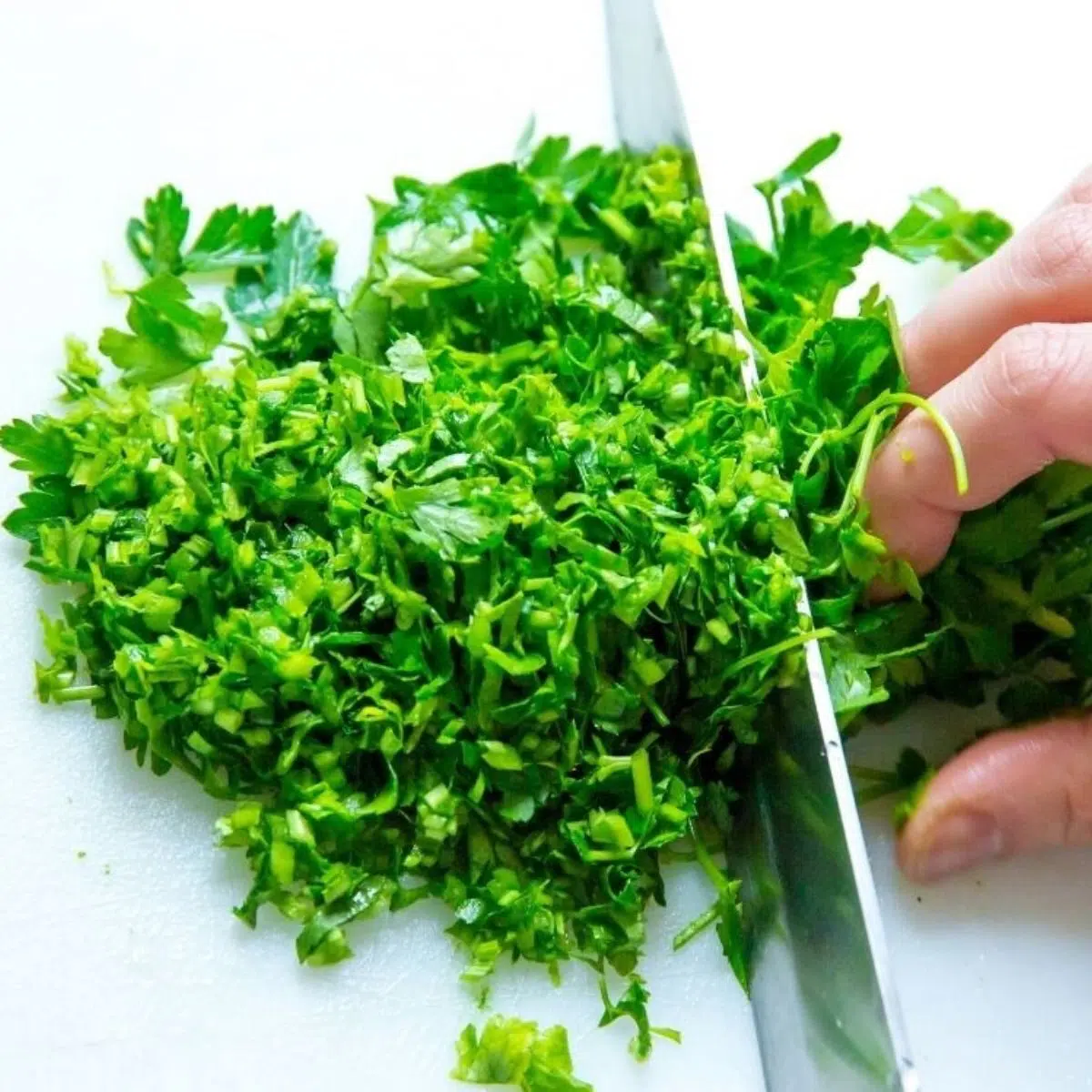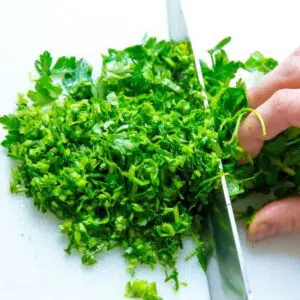If you run into needing a great parsley substitute in any recipe, you can read about all of the very best alternatives you can swap on the fly! They'll work wonderfully for preserving the flavor of any number of dishes seamlessly!

This versatile herb, whether fresh or dried, is much more than just garnish!
While a little sprig of parsley is most popular for garnishing dishes, it has many other purposes in the kitchen. Beyond its role as a garnish, parsley is an herb that is used to flavor dishes.
Parsley has a soft peppery taste that is a good addition to everything from eggs to soups and sauces. Compared to other herbs, its flavor is milder and less pronounced.
Jump to:
- The Best Parsley Substitutes
- Dried Parsley for Fresh Parsley (or vice versa)
- Flat-leaf Parsley for Curly-leaf Parsley (or vice versa)
- The Best Substitutes for Fresh Parsley
- 1. Fresh Arugula
- 2. Fresh Endive
- 3. Fresh Chives
- 5. Fresh Celery Leaves
- 6. Fresh Basil
- 7. Fresh Carrot Greens
- 8. Fresh Cilantro
- 9. Fresh Oregano
- The Best Substitutes for Dried Parsley
- 10. Dried Basil
- 11. Dried Oregano
- 12. Dried Tarragon
- 13. Dried Chervil
- 14. Dried Chives
- 15. More Dried Herb Alternatives
- Substituting Dried for Fresh Herbs (and vice versa)
- 📖 Recipe Card
- 💬 Comments & Reviews
Sometimes parsley even referred to it as being “flat” when compared to the bright taste of many other herbs.
Therefore, in many recipes, you can skip the parsley and still have a beautiful tasting dish. With so many herbs that can be used as substitutes though, you can still easily elevate the flavor of your dish.
The Best Parsley Substitutes
When choosing the best substitute for parsley the first thing to consider is if your recipe calls for dried or fresh parsley. This will give you a good starting point of whether to look for a fresh herb or dried herb as a substitute.
This doesn’t mean you have to use dried for dried or fresh for fresh. In fact, some of the easiest substitutes are to swap dried for fresh (or vice versa). However, there is a slight flavor difference between dried and fresh.
Dried herbs are more concentrated and often more potent than fresh herbs. Therefore, the ratio for substituting dried for fresh or fresh for dry is rarely a 1:1 substitution.
Again, this doesn’t mean you can’t use dried and fresh herbs interchangeably, it just takes a bit more attention when making your swap.
In addition to the substitutions below working to enhance the flavor in dishes, any of these will also work as a garnish!
Dried Parsley for Fresh Parsley (or vice versa)
If you've ever purchased a pre-filled spice rack, you may have dried parsley and not even know it. Give the spice rack a quick spin and see if you have parsley. In that case, you can use dried parsley to replace fresh parsley in most recipes.
Dried parsley is stronger than fresh parsley. Therefore, you will not need as much for your recipe.
The ratio of dried parsley to fresh parsley is ⅓ dried parsley for 1 serving of fresh parsley. For example, use 1 teaspoon of dried parsley to replace 1 tablespoon of fresh parsley.
- 1 teaspoon dried parsley = 1 tablespoon fresh parsley
You can also use fresh parsley in place of the dried version. Just use 3 times the amount of fresh parsley to replace the amount of dried parsley called for in your recipe.
Flat-leaf Parsley for Curly-leaf Parsley (or vice versa)
There are two main types of parsley that you will find in the grocery store: flat-leaf parsley and curly parsley.
Flat-leaf parsley is also called Italian parsley. This type of parsley has a stronger flavor compared to the curly-leaf parsley often used for garnish.
When replacing curly leaf with flat leaf it is best to start with a bit less (usually about ¾ of the volume the recipe calls for) and then add more as needed.
Going the other direction though, feel free to begin with an equal 1:1 exchange of curly-leaf parsley for flat-leaf parsley. Taste the dish and add more if needed.
The Best Substitutes for Fresh Parsley
These also happen to be the easiest to work with as you'll be replacing fresh herbs with other fresh herbs. You can always swap dried for fresh, just remember to start with much less!
Chervil and chives are our top picks of fresh herbs to substitute for parsley. The taste will deliver! However, for garnish, you can't go wrong with celery and carrot greens or a big bunch of fresh cilantro!
1. Fresh Arugula
Even though arugula is a member of the lettuce family, rather than an herb (like parsley) it tastes a lot like parsley. It has both the bitterness and peppery profile of parsley.
Therefore, fresh arugula can work well in many dishes that call for fresh parsley. However, it is best used in cold dishes.
Arugula is more pungent than parsley, so you want to start with about ½ of what the recipe calls for. Try ½ tablespoon of freshly chopped arugula for 1 tablespoon of fresh parsley.
2. Fresh Endive
You may be less familiar with endive than arugula. This simple salad green is similar in taste though. Slightly bitter and peppery – just like arugula and parsley.
Use endive the same way you would use arugula as a substitute. Try it in cold dishes and start with half of what the recipe calls for in parsley. You can always add more if needed.
In addition to its similar taste to parsley, endive also looks a lot like curly-leaf parsley which makes it a fun substitution for a green garnish.
3. Fresh Chives
Chives are an herb that is part of the allium family of vegetables. Other allium veggies include onions, garlic, leeks, and shallots.
While chives are not as pungent as some of their cousins in the allium family, it does resemble a mild oniony taste. This is quite different than the bitter and peppery flavor of parsley.
Although a distinctly different flavor profile, the flavor of chive can be a nice flavor exchange in many dishes that you want to add a punch of flavor to.
Fresh chives can be used in a 1:1 exchange for fresh parsley in a dish that will benefit from this flavor profile.
5. Fresh Celery Leaves
One of the first things most people do when they use celery is cut off the leafy tops and toss them in the trash. Gasp, WHAT? I love these greens! What they don’t realize is that the leafy greens on celery have a lot of flavor!
Celery leaves have an earthy yet pronounced flavor. While it is not as peppery as parsley, it makes a nice substitution in both hot and cold dishes that call for fresh parsley.
Use chopped-up celery leaves in a 1:1 substitution for fresh parsley. If using as a replacement for dried parsley, use 1 tablespoon of fresh celery leaves to replace 1 teaspoon of dried parsley.
6. Fresh Basil
Fresh basil can also be used in place of fresh parsley. The slightly sweet aromatic taste of fresh basil will be quite different than the peppery flavor of parsley.
However, basil pairs well with many of the same ingredients that parsley is commonly paired with. That said, I still would recommend using this robust herb primarily as a substitute in Italian cooking.
Use basil in a lesser quantity than the parsley called for in your recipe. Start with ½ the amount, taste, and adjust from there.
7. Fresh Carrot Greens
Celery isn’t the only vegetable with a leafy topping that resembles parsley. The green leaves that top your freshly harvested carrots are also a great parsley substitute.
Like parsley, carrot greens have a bitter and earthy taste. Although less peppery than parsley, these greens are a great substitute to add flavor to stews, sauces, and other dishes.
The only downside of carrot greens is that many store-bought carrots don’t have the greens still attached. If you buy carrots from a farmer’s market or grow them yourself though, give them a try!
Use chopped carrot greens in a 1:1 exchange for fresh parsley.
8. Fresh Cilantro
Cilantro looks a lot like parsley and has some similarities in taste. However, cilantro has a very distinct taste that people either love or hate.
Therefore, be mindful of who you are cooking for before using this as a substitute. If you know that you (and others you are cooking for) love cilantro, then go ahead and use this as a substitute for fresh parsley.
The peppery and citrus flavors of cilantro are more pungent than parsley and provide the best flavor when used raw in cold dishes. Since it is more pungent than parsley, it is best to begin by using less than the recipe calls for.
Use ½ a tablespoon of chopped cilantro in place of 1 tablespoon of fresh parsley. After tasting the dish, add more if needed.
9. Fresh Oregano
While almost everyone has dried oregano hiding in their cupboards, fresh oregano is less common. If you have some on hand though, feel free to explore a flavor exchange of fresh oregano for fresh parsley.
As with cilantro and basil, start with less and add more if needed. Use ½ tablespoon fresh oregano to each 1 tablespoon of parsley called for in your recipe.
The Best Substitutes for Dried Parsley
Swapping out dried herbs for dried parsley works just like the fresh herbs noted above. Try a variety out to find your favorites!
10. Dried Basil
While the flavor of basil is quite different than parsley, they are both used in many Italian dishes. Therefore, using basil in place of parsley can work to provide a familiar flavor profile for an Italian dish.
Dried basil is also much milder than fresh basil. This makes it easy to add to sauces, stews, and other hot dishes without overpowering the dish.
Use dried basil in a 1:1 substitution for dried parsley in hot and cold dishes.
11. Dried Oregano
Like basil, oregano is another herb that is often seen alongside parsley in Italian dishes. You may also see oregano and parsley used in Mexican cooking.
Oregano has a distinct earthy and slightly sweet flavor that is somewhat different than parsley. In many recipes though, it can be a nice flavor exchange for the parsley.
Oregano has a stronger flavor than parsley though, so you don’t want to use quite as much. Begin with ¼ to a ½ of what the recipe calls for in parsley.
Since it will change the flavor slightly, it is always best to start with less and then add more slowly over time.
12. Dried Tarragon
Tarragon is used in French cooking the way that oregano is used in Italian cooking. It is a common herb mixed with other herbs, including parsley, to provide a familiar flavor to French dishes.
On its own, tarragon has a distinctly different flavor than parsley. However, since it pairs well with parsley it can pair well with foods that parsley compliments. It works especially well when paired with chicken, egg, and whitefish.
Like other strong herbs, use a smaller amount of tarragon than parsley. Depending on how much flavor you want, begin with ¼ to ½ the volume of what the recipe calls for in dried parsley. Add more if needed.
13. Dried Chervil
Another great herb to replace parsley with is chervil. Since it's not a super commonly found herb in stores where you can buy fresh herbs, I've reserved mention for the dried herbs section.
This herb is very closely related in flavor to parsley which is what makes it such an extremely suitable substitute. The flavor is slightly more mild, so you may need to add more to taste.
Use dried chervil is a 1:1 equal ratio to dried parsley for substitution in any recipe.
14. Dried Chives
Chives are one of my top picks when substituting either fresh or dried herbs for parsley. The flavor is versatile and familiar, and chives are readily available dried and freeze dried.
Dried chives can also be used in place of dried parsley in a 1:1 exchange.
15. More Dried Herb Alternatives
There are many other dried herbs that can be used to replace dried parsley in a dish. Like some of the herbs mentioned above, many other dried herbs also have different flavor profiles than parsley.
If you are looking for an earthy and aromatic flavor to enrich a recipe though, try some of these other herbs in place of dried parsley.
- Dried Thyme
- Dried Marjoram
- Dried Sage
As each of these herbs has their own distinct flavors, once again begin with just a little bit, and add more as needed.
Substituting Dried for Fresh Herbs (and vice versa)
As mentioned earlier, it is always best to swap dried for dried or fresh for fresh. This provides the best flavor exchange between herbs. It also maintains the integrity of how the herbs were meant to be used in the recipe.
When looking for a substitute though, sometimes it is all about what is easily accessible. If you have to swap between dried and fresh, follow a couple of simple guidelines.
When swapping similar flavor profiles, use a 3 to 1 ratio of fresh to dried: 3 teaspoons of fresh herbs for 1 tablespoon of dried herbs.
When going from dried to fresh, a good guideline is 1 teaspoon of dried herbs for every tablespoon of fresh herbs.
If you are swapping a distinctly different flavor, follow the rule of starting with less and adding more as needed (for both dried to fresh and the other way around).
We'd love to hear about your parsley substitute that you like best for any recipe! Tell us what works best in your kitchen in the comments below!
Do you love a recipe you tried? Please leave a 5-star 🌟rating in the recipe card below and/or a review in the comments section further down the page.
Stay in touch with me through social media @ Pinterest, Facebook, Instagram, or Twitter! Subscribe to the newsletter today (no spam, I promise)! Don't forget to tag me when you try one of my recipes!
📖 Recipe Card
Best Parsley Substitute (Fresh or Dried): Chives and Carrot Greens (+More Easy Alternatives!)
Ingredients
Option 1 - Chives
- 1 tablespoon chives (fresh or dried chives)
Option 2 - Carrot Greens
- 1 tablespoon carrot greens
(Note: 2x or 3x only changes the ingredient list)
Instructions
Option 1 - Chives
- Use fresh chives in a 1:1 ratio to substitute for fresh parsley. Use dried or freeze dried chives in an equal 1:1 ratio again when substituting for dried parsley.
Option 2 - Carrot Greens
- Use fresh carrot greens in a 1:1 ratio to substitute for fresh parsley.
Notes
- These are the best flavor substitutions. Plenty of garnish substitutions are noted above in the post. Enjoy!
- Chives work exceptionally well for both fresh and dried alternatives. The taste is not exactly that of parsley, but always pleasing.



Concha says
Que útil me ha resultado toda la información sobre las hierbas frescas y secas como aderezo y me ha resuelto muchas dudas.
Mil gracias.
"How useful all the information about fresh and dried herbs as a dressing has been to me and it has resolved many doubts.
Thank you."